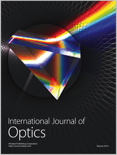
International Journal of Optics
Scope & Guideline
Advancing Knowledge Through Light
Introduction
Aims and Scopes
- Optoelectronic Devices and Applications:
Research on the design, characterization, and application of optoelectronic devices such as light-emitting diodes, lasers, and photonic sensors. - Nanophotonics and Plasmonics:
Exploration of light-matter interactions at the nanoscale, including the development of plasmonic structures and their applications in sensing and imaging. - Optical Materials and Nanostructures:
Study of novel optical materials, including two-dimensional materials and their integration into photonic devices for enhanced performance. - Advanced Imaging Techniques:
Development and application of sophisticated imaging methodologies, including holography, optical coherence tomography, and super-resolution techniques. - Terahertz and Microwave Optics:
Research on terahertz wave propagation, generation, and sensing, including applications in material characterization and biomedical sensing. - Optical Communication Systems:
Investigation of optical communication technologies, including fiber optics, free-space optics, and their integration into high-capacity networks. - Computational Optics and Machine Learning:
Application of computational methods and machine learning techniques in optical design, image processing, and data analysis. - Biomedical Optics:
Research focused on optical techniques applied to biomedical fields, including biosensing, imaging, and therapeutic applications.
Trending and Emerging
- 2D Materials in Optics:
There is a growing body of research focusing on the optical properties and applications of two-dimensional materials, such as graphene and transition metal dichalcogenides, in photonics. - Terahertz Technology:
The exploration of terahertz waves for sensing and imaging applications has surged, reflecting the expanding interest in this frequency range for both fundamental studies and practical applications. - AI and Machine Learning in Optical Systems:
The integration of artificial intelligence and machine learning techniques into optical systems and analysis has gained traction, enhancing capabilities in data processing and system optimization. - Bio-Optics and Health Applications:
Research on optical techniques for healthcare, including biosensing and imaging technologies, is increasingly relevant, particularly in response to global health challenges. - Photonic Integrated Circuits:
The development of integrated photonic devices that combine multiple functionalities on a single chip is an emerging focus, driven by the demands of telecommunications and data processing.
Declining or Waning
- Traditional Optical Imaging Techniques:
There has been a noticeable decrease in papers focused solely on conventional optical imaging methods, as newer, more advanced techniques gain popularity. - Basic Laser Physics Studies:
Research centered around fundamental laser physics has become less prominent, possibly due to the increasing complexity of applications that integrate multiple disciplines. - Static Optical Sensors:
The focus on static optical sensors has diminished, likely as researchers shift towards more dynamic and multifunctional sensor systems. - Single-Photon Detection:
The interest in single-photon detection technologies appears to be declining, potentially overshadowed by advancements in integrated photonic circuits and other detection methods. - Optical Coherence Tomography (OCT) for Standard Applications:
While OCT remains important, the basic applications of OCT are seeing reduced emphasis as more specialized and novel applications emerge.
Similar Journals
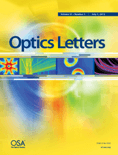
OPTICS LETTERS
Shaping the Landscape of Optics Since 1977OPTICS LETTERS is a premier academic journal published by the Optica Publishing Group, dedicated to advancing the field of optics and photonics. Since its inception in 1977, it has maintained a strong reputation for publishing high-impact research, holding a distinguished Q1 category ranking in Atomic and Molecular Physics, as well as Optics, making it a vital resource for researchers and professionals alike. With an impressive Scopus rank of #55 out of 224 in its field, OPTICS LETTERS continues to shape the discourse and innovation in optical science. Authors benefit from its extensive international reach, while readers gain access to cutting-edge studies that address both theoretical and applied aspects of optics. Although the journal currently does not offer open access options, its rigorous peer-review standards ensure that every publication meets the highest academic criteria, making it an essential journal for anyone looking to stay at the forefront of optical research.
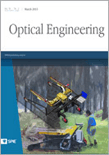
OPTICAL ENGINEERING
Advancing the frontiers of optical innovation.OPTICAL ENGINEERING, published by SPIE-SOC PHOTO-OPTICAL INSTRUMENTATION ENGINEERS, is a premier journal in the field of optical and photonic engineering, dedicated to advancing the science and technology of optics, photonics, and imaging systems. With ISSN 0091-3286 and E-ISSN 1560-2303, this esteemed publication has been contributing to the academic community since its inception in 1972, covering a wide array of topics within its converged years of operation. As a recognized entity, the journal is presently positioned in the Q3 quartile for Atomic and Molecular Physics and Optics, and in the Q2 quartile for Engineering (miscellaneous) as of 2023. The journal’s Scopus ranks reflect its impact and significance, being placed at #129 out of 307 in General Engineering and #137 out of 224 in Atomic and Molecular Physics. Although it does not operate under an open access model, the journal remains a vital resource for researchers, professionals, and students seeking the latest advancements in optical engineering. With a focus on publishing innovative research and technical advancements, OPTICAL ENGINEERING continues to be essential for driving progress in this crucial scientific field.
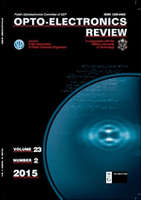
OPTO-ELECTRONICS REVIEW
Advancing Knowledge at the Intersection of Light and TechnologyOPTO-ELECTRONICS REVIEW, published by the Polish Academy of Sciences, is a prestigious peer-reviewed journal that has been at the forefront of research in the fields of electrical and electronic engineering, materials science, and radiation since its inception in 1996. With an ISSN of 1230-3402 and an E-ISSN of 1896-3757, the journal serves as a vital platform for disseminating high-quality research that explores the intersection of optoelectronics with cutting-edge technological advancements. Operating from its headquarters in Warsaw, Poland, OPTO-ELECTRONICS REVIEW reaches an international audience, contributing significantly to the body of knowledge in its categorically ranked quartiles, specifically Q3 in Electrical and Electronic Engineering and Materials Science for 2023. Researchers will find valuable insights as the journal continues to embrace emerging trends while maintaining rigorous academic standards. Although currently not open access, the journal remains an essential resource for professionals and students seeking to enhance their understanding and application of optoelectronic technologies.

OPTICAL AND QUANTUM ELECTRONICS
Connecting Theory and Application in Quantum ElectronicsOPTICAL AND QUANTUM ELECTRONICS, published by SPRINGER, is a premier journal dedicated to advancing the fields of atomic and molecular physics, optics, and electronic engineering. With an ISSN of 0306-8919 and an E-ISSN of 1572-817X, this journal has established itself as a vital resource for researchers, professionals, and students alike, contributing to the discourse from its inception in 1969 to its continued publications through 2024. It holds impressive rankings in Scopus, placing within the top percentiles for its categories, specifically in the 64th for Electrical and Electronic Engineering and 63rd for Atomic and Molecular Physics. Though it does not currently offer open access options, the journal's robust impact factor reflects its importance within its field, making it an essential reference point for cutting-edge research and developments in materials science and optics. Through its rigorous peer-review process, OPTICAL AND QUANTUM ELECTRONICS remains committed to publishing high-quality, influential studies that push the boundaries of innovation and understanding in these dynamic areas of science.
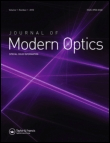
JOURNAL OF MODERN OPTICS
Exploring the Frontiers of Optical InnovationJOURNAL OF MODERN OPTICS, published by Taylor & Francis Ltd, stands as a prominent bi-monthly journal contributing to the fields of Atomic and Molecular Physics and Optics. With an ISSN of 0950-0340 and an E-ISSN of 1362-3044, this journal aims to disseminate high-quality research that pushes the boundaries of optical science and its applications. Since its inception in 1981, and particularly throughout its publications from 1987 to 2024, the journal has consistently published influential studies that are essential for both academic researchers and industry professionals. Ranked in the Q3 quartile for the 2023 category of Atomic and Molecular Physics and Optics, it has a Scopus ranking of #133 out of 224, indicating its steady presence and relevance in the scientific community. Although it does not offer Open Access options, readers can access its rich repository of literature that delves into innovative optical methods, technological advancements, and theoretical frameworks. The JOURNAL OF MODERN OPTICS is an indispensable resource for those seeking to advance their knowledge and research in modern optical science.

Advanced Optical Technologies
Advancing Knowledge in Optics and PhotonicsAdvanced Optical Technologies is a reputable journal dedicated to advancing the field of optics and photonics, published by FRONTIERS MEDIA SA in Switzerland. Since its inception in 2012, the journal has made significant contributions to the domains of Atomic and Molecular Physics, Electronic, Optical and Magnetic Materials, and Instrumentation, achieving commendable rankings within these categories, including a Q2 quartile classification in 2023. With an emphasis on open access, Advanced Optical Technologies aims to facilitate the rapid dissemination of research findings, thereby fostering collaboration and innovation among researchers, professionals, and students alike. The journal serves as an essential platform for cutting-edge research articles, reviews, and technical notes, and its commitment to quality is reflected in its robust Scopus rankings. As the field of optical technologies continues to expand, this journal plays a crucial role in highlighting pivotal advancements and promoting interdisciplinary dialogue among scholars in the scientific community.

Nonlinear Optics Quantum Optics-Concepts in Modern Optics
Advancing Knowledge in Nonlinear and Quantum OpticsNonlinear Optics Quantum Optics-Concepts in Modern Optics is a specialized journal published by OLD CITY PUBLISHING INC, focusing on the forefront of research in nonlinear optics and quantum optics. With an ISSN of 1543-0537 and an E-ISSN of 1944-8325, this journal serves as a pivotal platform for the dissemination of innovative concepts and findings in modern optics, significant for both theoretical exploration and practical applications. Established in 2003, the journal's scope encompasses critical areas such as atomic and molecular physics, optical materials, and instrumentation, attracting submissions from a diverse range of interdisciplinary fields. While the journal currently maintains a Q4 ranking in several categories, it continues to strive for higher visibility and impact in the academic community. Researchers and students alike will find valuable insights and contributions that foster advancements in optical science and engineering. With an emphasis on rigorous peer-review, Nonlinear Optics Quantum Optics-Concepts in Modern Optics is committed to enhancing the understanding and application of nonlinear optical phenomena in various technological domains.

Advances in Optics and Photonics
Leading the Charge in Photonic Research ExcellenceAdvances in Optics and Photonics, published by the Optica Publishing Group, stands at the forefront of research dissemination in the fields of Atomic and Molecular Physics and Optics, alongside its prominence in Water Science and Technology. With an impressive Q1 ranking in both categories and a Scopus rank of #2/224, this journal boasts a 99th percentile status, underscoring its significance in the academic community. As a beacon of knowledge since its inception in 2009, the journal is dedicated to featuring cutting-edge research, innovative methodologies, and transformative applications in optics and photonics that can drive advancements across diverse scientific domains. While not an open-access journal, it provides vital insights for researchers, professionals, and students eager to stay updated on emerging trends and breakthroughs. With a convergence period extending to 2024, Advances in Optics and Photonics is positioned as an essential resource for anyone looking to explore the evolving landscape of light-based technologies.

JOURNAL OF THE OPTICAL SOCIETY OF AMERICA B-OPTICAL PHYSICS
Illuminating the Future of Optical ScienceJOURNAL OF THE OPTICAL SOCIETY OF AMERICA B-OPTICAL PHYSICS, published by Optica Publishing Group, serves as a leading platform for groundbreaking research in the fields of optical physics, atomic and molecular physics, and statistical and nonlinear physics. With an ISSN of 0740-3224 and an E-ISSN of 1520-8540, this esteemed journal has been in circulation since 1984 and is dedicated to advancing the understanding of optical phenomena and related technologies. It holds a commendable position in the academic community, with a 2023 Scopus ranking reflecting its significance—placing it in the top quartile for both Atomic and Molecular Physics and Statistical and Nonlinear Physics. Although it is not an open-access publication, it provides extensive access options to ensure that research is disseminated effectively within the scientific community. This journal is instrumental for researchers, professionals, and students alike, aiming to keep them informed of the latest advancements and trends in optical science. With a convergence of expertise and innovation, JOSA B continues to play a pivotal role in shaping the future of optical research.

Optica
Exploring the frontiers of optical science and materials technology.Optica is a premier open-access journal published by the Optica Publishing Group, designed to disseminate high-quality research across the fields of Atomic and Molecular Physics and Optics. Since its inception in 2014, it has established itself as a vital resource for the scientific community, as evidenced by its impressive Q1 rankings in both relevant categories in 2023 and its notable positions in the Scopus rankings—#9 in Atomic and Molecular Physics and #13 in Materials Science. Featuring cutting-edge research from leading experts, Optica aims to foster innovation and collaboration by providing unrestricted access to groundbreaking discoveries and advancements. Researchers, professionals, and students alike will find invaluable insights and trends that drive the ever-evolving scope of optical science and materials technology. With its commitment to open access, Optica ensures that knowledge is accessible, empowering the global community of scientists and researchers to embark on new explorations.